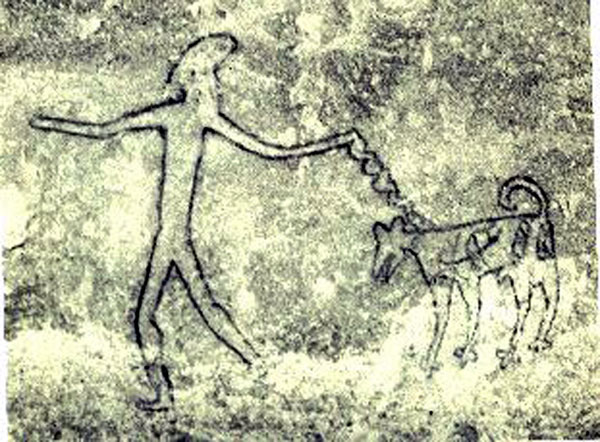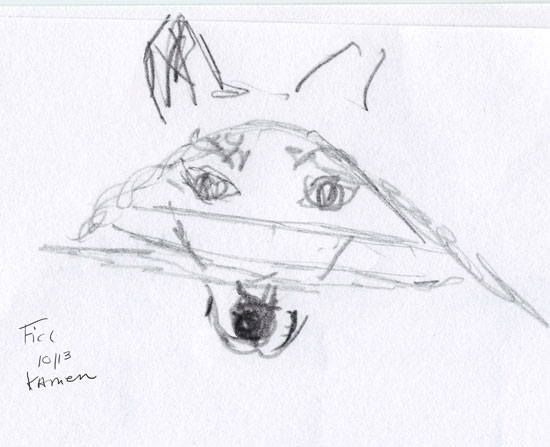Volume XVII, Issue 4, November 2013
Page 10 < previous page > <next page>
Rethinking dog domestication by integrating genetics, archeology, and biogeography.
Greger Larsona,1, Elinor K. Karlssonb,c, Angela Perria, Matthew T. Webster d, Simon Y. W. Hoe, Joris Petersf, Peter W. Stahl g, Philip J. Piperh,i, Frode Lingaasj, Merete Fredholmk, Kenine E. Comstockl, Jaime F. Modianom,n, Claude Schellingo, Alexander I. Agoulnikp, Peter A. Leegwaterq, Keith Dobneyr, Jean-Denis Vignes, Carles Vilàt, Leif Anderssond,u, and Kerstin Lindblad-Tohb,d

Abstract:
The dog was the first domesticated animal but it remains uncertain when the domestication process began and whether it occurred just once or multiple times across the Northern Hemisphere. To ascertain the value of modern genetic data to elucidate the origins of dog domestication, we analyzed 49,024 autosomal SNPs in 1,375 dogs (representing 35 breeds) and 19 wolves. After combining our data with previously published data, we contrasted the genetic signatures of 121 breeds with a worldwide archeological assessment of the earliest dog remains. Correlating the earliest archeological dogs with the geographic locations of 14 so-called “ancient” breeds (defined by their genetic differentiation) resulted in a counterintuitive pattern. First, none of the ancient breeds derive from regions where the oldest archeological remains have been found. Second, three of the ancient breeds (Basenjis, Dingoes, and New Guinea Singing Dogs) come from regions outside the natural range of Canis lupus (the dog’s wild ancestor) and where dogs were introduced more than 10,000 y after domestication. These results demonstrate that the unifying characteristic among all genetically distinct so-called ancient breeds is a lack of recent admixture with other breeds likely facilitated by geographic and cultural isolation. Furthermore, these genetically distinct ancient breeds only appear so because of their relative isolation, suggesting that studies of modern breeds have yet to shed light on dog origins. We conclude by assessing the limitations of past studies and how next-generation sequencing of modern and ancient individuals may unravel the history of dog domestication.
 Kamen Doodle
Kamen Doodle
Darwin speculated about the origins of several domestic animals and suggested that, given the vast morphological variation across numerous breeds, dogs must have had more than one wild ancestor (1). Recent genetic studies, however, support the notion that dogs are descended exclusively from the gray wolf (Canis lupus) (2). Beyond questions regarding wild ancestry, geneticists and generations of archeologists have investigated not only how and why dogs were domesticated, but also when, where, and how many times it may have occurred. Unique among all domestic animals, the first unambiguous domestic dogs precede the appearance of settled agriculture in the archeological record by several thousand years. Identifying the earliest dogs is difficult, however, because key morphological characters established by zoo archeologists to differentiate domestic animals from their wild wolf ancestors (e.g., size and position of teeth, dental pathologies, and size and proportion of cranial and postcranial elements) were not yet fixed during the initial phases of the domestication process. Furthermore, the range of natural variation among these characters in ancient wolf populations and the time it took for these traits to appear in dogs are unknown. Free-ranging wolves attracted to the refuse generated by human camps most likely followed a commensal pathway to domestication that was neither deliberate nor directed (3). Because the process was not unidirectional, the telltale traits archeologists use to differentiate wolves and dogs probably took numerous generations to become apparent in the archeological record.
Despite the difficulties associated with the use of archeological evidence to pinpoint the timing of domestication, there is a general consensus that domestic dogs were present in the Levant (including Cyprus), Iraq, Northern China, and the Kamchatka peninsula in Far Eastern Russia by ∼12,000 y ago, and in western Europe a few millennia before that. Recent studies have made claims that domestic (or incipient) dogs were present even earlier during the Late Pleistocene in Belgium (4), the Czech Republic (5), and southwestern Siberia (6). Morphological analyses suggest that although some of the early canid remains possess characteristics broadly similar to those found in modern dogs, it remains possible that the bones represent either wolves going through the initial phases of an incomplete domestication process (6) or a morphologically distinct local, now-extinct population of wolves. The use of more advanced morphometric analyses is allowing zooarcheologists to have greater confidence in identifying early dogs (7). Given the geographical breadth of these finds, archeologists have (generally) been reluctant to postulate exact locations where dogs may have been domesticated. Instead, they have broadly accepted the plausibility of the existence of numerous, independent centers of dog domestication beginning in the Late Pleistocene (8).
Many genetic studies of modern dogs and wolves have been less circumspect. Armed first with fragments of mitochondrial DNA and molecular clocks, the authors of one study concluded that dogs were domesticated 135,000 y ago (9). A separate study later analyzed a similar mitochondrial fragment sequenced from 654 dogs and, on the basis of regional patterns of modern dog diversity, deduced that dogs were domesticated just once in East Asia (10).
Both of these claims have since been challenged. First, it is highly likely that the use of deep fossil calibrations for molecular clocks has led to a significant overestimation of the timing of dog domestication (11). Second, analyses of African street dogs suggested that a single East Asian origin was too simplistic (12). A study of 48,000 SNPs in 912 dogs and 225 gray wolves concluded that both East Asian and Near Eastern wolf populations contributed DNA to modern dog breeds (13). Other studies that have incorporated nuclear markers also suggest diverse geographic origins of dogs (14), and with the application of a broader, more integrated approach, the genetic and archeological perspectives have become more closely aligned. However, despite the volume of new data, the estimates of when, where, and how many times dogs were domesticated remain disconcertingly imprecise. One significant insight that genetic studies have yielded, using both microsatellites (15) and SNPs (13), is the identification of several genetically divergent modern dog breeds in well-supported basal positions on phylogenetic trees. This early-branching pattern has been used to designate these breeds as “ancient” (13). To avoid conflating genetic differentiation with presumed ancient heritage (16), we will instead refer to these lineages as “basal.”
The term “breed” is also problematic. The focus on general classes of dogs (e.g., sight hounds, scent hunters, shepherd dogs, and giant dogs) likely has prehistoric roots and led to the development of broadly distinct forms of dogs. For example, three differently sized dog types have been recorded at the 8,000-y-old Svaerdborg site in Denmark (17). Modern breeding practices, focused on distinct breeds with strict aesthetic requirements and closed bloodlines, only emerged in the 19th century, and claims for the antiquity (and long-term continuity) of modern breeds are based upon little or no historical or empirical evidence. In fact, recent historical records clearly demonstrate that most modern breeds experienced significant population fluctuations within the past 100 y (Table S1). Here, we only use the term “breed” when referring to modern dog breeds recognized by kennel clubs.